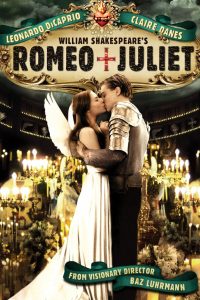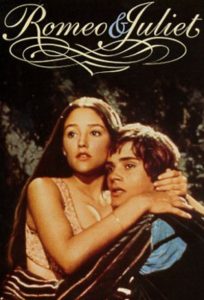

Act 3 scene 1 of Shakespeare’s Romeo and Juliet culminates in the death of Tybalt by Romeo’s hands, as they duel over the fate of Mercutio. Romeo, seeking vengeance for his friend, lets his emotions overcome him, furthering the gap between himself and his love, Juliet. The scene dramatically ends with Romeo’s bitter line, “I am fortune’s fool” (3.1.98). Both Zeffirelli’s and Luhrmann’s film versions of Romeo and Juliet use this statement in differing ways. Not only are the deliveries completely unalike, but, also, the contexts lend further insight into the directors’ separate styles and artistic visions.
In Baz Luhrmann’s version, a car crash and a battle over the weapon, a single hand gun, supply the most tension within the action sequence. Luhrmann uses shaky camera work, slow motion and extreme facial close ups during the car accident to heighten the drama and pivot the scene to the character’s confrontation. Choral and electronic music used in tandem intensifies each moment. Both the music and the camera alternately slow and speed up, and the overall effect is one of disorientation and urgency.
At one point, Romeo is held at gunpoint by Tybalt. A terse, vehement exchange follows and, with crazed passion, Romeo repeats the line, “Either thou or I, or both, must go with him” (3.1.91). With each repetition, Romeo seems to become more incensed, and with the final repeat, Romeo yells the line like a war cry. The emphasis on these repeated lines is almost prophetic; Romeo seems to believe he is helpless at the hands of fate, and the only path ahead of him is death. When Romeo shoots Tybalt, the facial closeups mimic both points of view — staring down the barrel of the gun, and watching the life leave Tybalt’s eyes. It is interesting to note that this effect is used instead of a wide shot, where the action would have been seen more clearly. Tybalt’s body falls backwards, viewed from above, which is consistent with the lofty and spiritual themes of the scene. Realization dawns on Romeo as the camera cuts back to his face, pans down his arm, and he drops the gun. The music is gone, and the only sounds are from the storm around him. Romeo screams “I am fortune’s fool” (3.1.98) to heavens above with the camera panning upwards. The scene ends with the camera looking down on Romeo once more, again mimicking a point of view; seemingly of a higher being in control of Romeo’s fate.
Zeffirelli’s version of Act 3 scene 1 is much different. It’s brawling, gritty and visceral. The fight quickly escalates from a passionate duel to an animalistic struggle in the dirt of the street. In this version, Romeo is a more human character embroiled with rage, instead of a crazed prophet driven mad by vengeful justice and destiny. There is no music — only the constant yelling of the two boys’s comrades as they race down the alleyways. The whole group is very mobbish, both fighting each other and watching the real fight simultaneously, each egging on their respective leaders in the duel. The youthfulness of all the characters is emphasized in this version. Each contributing element reflects the innocence and energy of youth, as well as its crude, primal aggression.
Tybalt’s dead body falls forwards onto Romeo, instead of backwards and away from him. This physical connection in death is more human, and thus the fault of the situation lies in the hands of human error more than the whims of fate. The scene again ends with the line, “I am fortune’s fool,” (3.1.98) except here, Romeo cries it out in bitter regret and sorrow.
Both versions of this scene show different sides of chaos, passion and rage. Luhrmann’s Romeo is more focused on the act of killing, speaking of it as if an absolute and unquestionable force was directing him. He seems half-mad; the chaos of the scene is reminiscent of disorientation and helplessness. In the end, Romeo seems to put the blame of the murder in the hands of fate, not himself. Zeffirelli’s version, by contrast, is animalistic and primal. The fight is a brawl that is rife with rage and the intent to kill. It is never verbalized. The murder is a result of human passion rather than an act of fate. Romeo seems to regret his actions and puts the fault on himself. In all, both versions effectively represent the inherent deep emotion of the scene.
Leave a Reply
You must be logged in to post a comment.